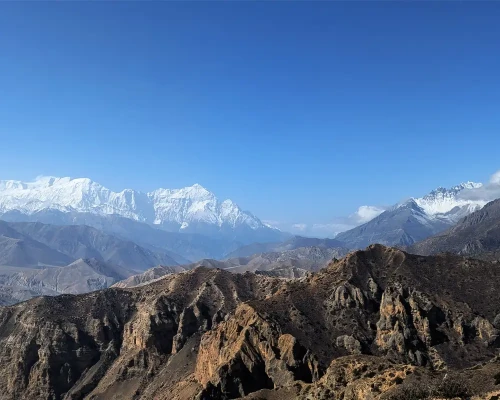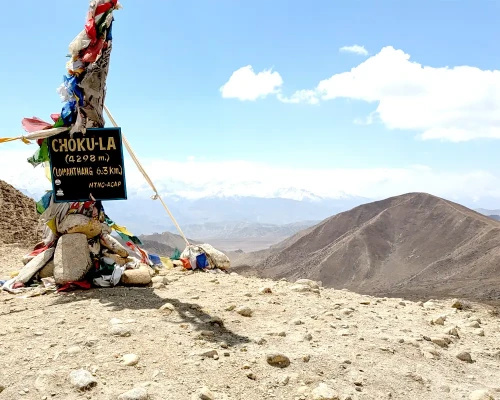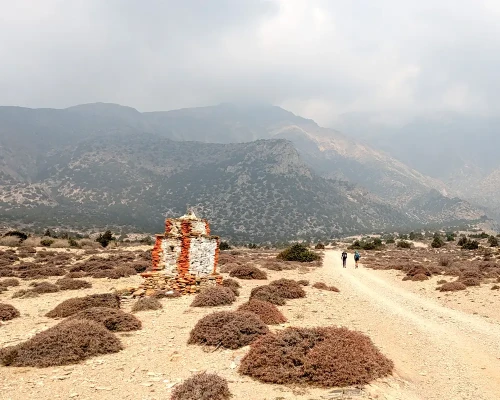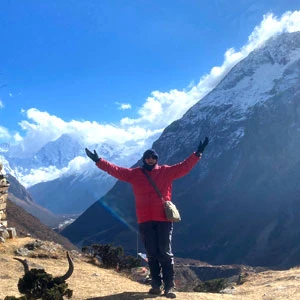Upper Mustang Overland Tour
The Upper Mustang Overland Tour is a journey through the once-forbidden Kingdom of Lo, located in the remote northwestern region of Nepal, near the border with Tibet. This high-altitude desert region lies in the rain shadow of the Annapurna and Dhaulagiri ranges. Hence, you will find a stark, arid landscape dramatically different from the lush hills typically associated with Nepal.
This particular tour is conducted entirely by a private 4WD vehicle, thus eliminating the need for strenuous trekking. During the journey, you will follow centuries-old trade routes that once linked Nepal and Tibet.
Upper Mustang holds immense historical and cultural significance. Until 1992, this region was closed to foreigners. Additionally, the tour’s focal point, Lo Manthang, was once the walled capital of the Kingdom of Lo, ruled by a king until the monarchy was abolished in the 2000s.
Even today, this medieval city still retains its fortified walls, labyrinthine alleys, royal palace, and ancient monasteries adorned with sacred relics. The region is inhabited primarily by the Loba people, an ethnically Tibetan community that follows Tibetan Buddhism and speaks a dialect closely related to classical Tibetan.
Scenic Landscapes And Cultural Beauty in the Upper Mustang, Nepal
While this tour begins in the vibrant Kathmandu city, the real adventure starts from Pokhara. Pokhara is a tranquil city nestled beside the serene Phewa Lake and overlooked by the Annapurna range.
The surrounding hills of this valley are dominated by the inhabitants of the Gurung, Magar, and Khas communities. If you are traveling during major celebrations like Dashain, Tihar, Maghe Sankranti, or Lhosar, you will have an opportunity to witness their traditional dance performances, such as the Sorathi and Ghatu.
Leaving Pokhara, the route takes you to Tatopani, a picturesque village where you can pause to soak in its therapeutic hot springs. True to its name, Tatopani translates to “hot water” in Nepali.
This particular village is dominated by the Gurung and Magar communities. Once you step within this village, you will be surrounded by terraced slopes, lush forests, and cascading waterfalls. Also, while here, you will get to sip a warm cup of coffee while overlooking the breathtaking views of the Annapurna and Dhaulagiri ranges.
Along the way to Tatopani from Pokhara, you will drive through lush mid-hill forests, terraced fields, and traditional settlements, gradually transitioning into the Kali Gandaki Valley, the world's deepest gorge.
Tatopani onwards, the landscape starts to change dramatically. The drive to Muktinath, a sacred pilgrimage site for both Hindus and Buddhists, climbs through the rugged, windswept terrain of Mustang. Along the way to this sacred site, you will cross through the charming villages of Ghasa, Marpha, and Jomsom, where the arid highlands begin to dominate the scenery.
Here, Muktinath is nestled beneath the Thorong La Pass and is one of the world’s highest temples at an altitude of 3,800 meters. This temple is a symbol of religious harmony in Nepal where both Hindus and Buddhists worship on the same spot respecting each other.
According to the legends, in Hindu texts, Muktinath is the Tiru Shaligramam and revered as the source of Shaligram Shila. It is one of the Char Dhams in Nepal and is known as the “Mukti Kshetra,” aka the palace of liberation.
As for Tibetan Buddhist tradition, Guru Rinpoche (Padmasambhava) meditated here on his journey to Tibet. For Buddhists, Muktinath is an abode of dakinis, aka sky dancers.
After paying respects here, the journey continues to Kagbeni, which is a medieval village that marks the gateway to Upper Mustang. Here, you will witness narrow alleys, prayer wheels, and windswept rooftops. Being one of the oldest villages in the Himalayas, it introduces you to the traditional Tibetan-style architecture and culture.
Driving deeper into the restricted Upper Mustang region, the road becomes more rugged and dramatic, taking you through high-altitude desert and narrow canyons. The next stop is Ghami, a quiet village known for its long mani wall, the longest in Mustang. It is set against crimson cliffs and wind-carved rock formations.
But before you reach Ghami, you will first stop at Chungsi Cave. Unlike many other man-made caves in Mustang, Chungsi is a natural wonder. As you peek inside this cave, its wall represents the silhouette of various deities that are all naturally formed.
As per the legends, this cave is believed to be a sacred meditation site used by Guru Rinpoche. Likewise, it is also said to have a connection to the Hindu God, Shiva, as he also had meditated here.
After you explore the cave, you will resume your journey to reach the Ghami village. Once here, you will get to witness houses made with stone, mud, straw, and wood with intricate carvings on the door and window. All the alleys in this village area are decorated with colorful prayer flags, Mani walls, and Chortens.
Moving on, the locals of Ghami are mainly Buddhist and follow the ancient Tibetan culture. People here rely on agriculture and animal husbandry for their livelihood.
From Ghami, the route then leads to Charang. But before reaching Charang, you will get to visit the Lo Gekar Monastery aka Ghar Gompa. This monastery dates back to 1200 years and comes to life during special occasions with butter lamps and chanting of prayers.
Now, Charang is the second-largest village in the entire Mustang region. It is a windswept plateau settlement famous for its imposing red-walled monastery and ancient palace ruins. A fun fact, Charang used to be the former capital of the Kingdom of Lo.
This particular village houses several monasteries and chortens, all of which are around 500 years old. Likewise, you will also find the local monastery, the Charang Gompa. This monastery has its entire inner wall painted with murals depicting the deities of the Medicine Buddha mandala.
Following it, your next day’s drive will continue through wide valleys and barren hills to the walled city of Lo Manthang, the cultural heart of Upper Mustang.
Before reaching Lo, you will visit and explore the Yara village and Luri Gompa. Situated at an altitude of 3,607 meters, Yara is famous for its ancient caves, hamlets, and monastery.
Once here, you will be surrounded by magnificent Himalayas, barren landscapes, and houses made of mud and stones. As you explore this village, you will find people heavily relying on agriculture and animal husbandry.
Here onwards, you will explore the spiritual ambiance of Luri Gompa, a cave monastery nestled high in the cliffs. This gompa is located ahead of Ghara village, and it is associated with the Nyingma Kargyupa sect of Tibetan Buddhism.
Within the Damodar Kunda Rural Municipality, this monastery is located 100 meters high on steep rock cliffs. It is surrounded by Tibetan prayer flags, caves, and chortens.
Once in Lo Manthang, you will be surrounded by a 6 meter high earther wall that borders this settlement. Within these walls, you will find royal palaces, several rows of chortens, mani walls, and monasteries like Jampa Lhakhang and Thubchen Gompa. The locals residing here are the Lobas and the culture here is largely defined by Sakyapa traditions of Tibetan Buddhism.
Staying in Lo Manthang, you will also take a side trip to the Korala border, the ancient trade pass between Nepal and Tibet. This border is situated at an altitude of 4,660 meters and the locals here can cross this border for trading purposes at a designated hour with an annual permit issued by Mustang’s District Administration Office.
On the return after the visit to the border, you will have a quick visit to Choser that introduces sky caves carved into cliffs. Situated at an altitude of 3,857 meters, this village showcases a network of caves which are believed to be burial chambers, dwellings, or meditation cells used over 2,000 years ago.
Another highlight of this village are the monasteries that date back to the 14th century. People here are known for their hospitality and traditional culture. The villagers here heavily rely on agriculture and animal husbandry.
Then, you will begin the descent through Marpha. It is a picturesque village known for its apple orchards, whitewashed homes, and the unique Marpha brandy distillery. It is also a common stop point for those who are trekking in Annapurna Circuit.
Altogether, the journey ends back in Pokhara before returning to Kathmandu.







 based on 6 reviews
based on 6 reviews

